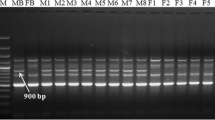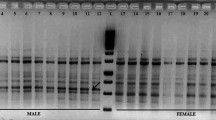Abstract
Garden asparagus (Asparagus officinalis L.) is a dioecious species, with male [XY] and female [XX] individuals. Since male individuals are preferred over females for agricultural production, all-male cultivars have agronomic advantages over mixed-sex cultivars. To produce an all-male cultivar, it is important to obtain a supermale [YY]. Given their morphological similarities, males and supermales are usually distinguished by genetic analysis. To reduce the time required for asparagus breeding, various dominant and codominant male-specific DNA markers have been developed to date. Although two sex-linked codominant markers (Asp2-SP6 and RM17) have been reported previously, their ability to distinguish the sex in A. officinalis and other dioecious Asparagus species has not been evaluated extensively. Therefore, we analyzed the application of these markers to A. officinalis, purple asparagus cultivars and other dioecious Asparagus species in this study. Our results showed that the capacity of these markers to distinguish the sex in A. officinalis and purple asparagus cultivars was limited, thus we developed a new CAPS marker (SSM01), based on the sequence around the RM17 marker. Since SSM01 amplify ca. 470 bp fragment and only Y-specific fragment was digested into ca. 270/200 bp by XspI, this marker can discriminate between females, males and supermales. SSM01 is applicable for discrimination between X- and Y-specific sequences in various A. officinalis and purple asparagus cultivars, also in three dioecious Asparagus species.





Similar content being viewed by others
Data availability
All data generated or analysed during this study are included in this published article and its supplementary information files.
References
Benson BL, Mullen RJ, Dean BB (1996) Three new green asparagus cultivars; Apollo, Atlas and Grande and one purple cultivar, purple passion. Acta Hort 415:59–65
Biffi R, Restivo FM, Caporali A, Marziani GP, Spada A, Falavigna A (1995) A restriction fragment length polymorphism probe for early diagnosis of gender in Asparagus officinalis L. Hort Sci 30:1463–1464
Falavigna A, Casali PE, Taccomi MG (1990) Potential of in vitro anther culture technique for asparagus. Acta Hort 271:39–46
Falavigna A, Casali PE, Taccomi MG (1996) Advances in asparagus breeding following in vitro anther culture. Acta Hort 415:137–142
Falloon PG, Andersen AM (1999) Breeding purple asparagus from tetraploid “Violetto d’Albenga.” Acta Hort 479:109–113
Gao WJ, Li RL, Li FS, Deng CL, Li SP (2007) Identification of two markers linked to the sex locus in dioecious Asparagus officinalis plants. Russ J Plant Physiol 54:816–821
Harkess A, Zhou J, Xu C, Bowers JE, Van der Hulst R, Ayyampalayam S, Mercati F, Riccardi P, McKain MR, Kakrana A, Tang H, Ray J, Groenendijk J, Arikit S, Mathioni SM, Nakano M, Shan H, Telgmann-Rauber A, Kanno A, Yue Z, Chen H, Li W, Chen Y, Xu X, Zhang Y, Luo S, Chen H, Gao J, Mao Z, Pires JC, Luo M, Kudrna D, Wing RA, Meyers BC, Yi K, Kong H, Lavrijsen P, Sunseri F, Falavigna A, Ye Y, Leebens-Mack JH, Chen G (2017) The asparagus genome sheds light on the origin and evolution of a young Y chromosome. Nat Commun 8:1279
Honda H, Hirai A (1990) A simple and efficient method for identification of hybrids using nonradioactive rDNA as probe. Jpn J Breed 40:339–348
Horiuchi K, Adachi Y, Kasai N, Yamagishi M, Masuda K (2011) Identification of homozygous male plants by quantitative analysis of a nucleotide sequence linked to the sex-determination locus in Asparagus officinalis L. J Jpn Soc Hort Sci 80:308–313
Ii Y, Uragami A, Uno Y, Kanechi M, Inagaki N (2012) RAPD-based analysis of differences between male and female genotypes of Asparagus officinalis. Hort Sci (prague) 39:33–37
Ito T, Konno I, Kubota S, Ochiai T, Sonoda T, Hayashi Y, Fukuda T, Yokoyama J, Nakayama H, Kameya T, Kanno A (2011) Production and characterization of interspecific hybrids between Asparagus kiusianus Makino and A. officinalis L. Euphytica 182:285–294
Jamsari A, Nits I, Reamon-Büttner SM, Jung C (2004) BAC-derived diagnostic markers for sex determination in asparagus. Theor Appl Genet 108:1140–1146
Jiang C, Sink KC (1997) RAPD and SCAR markers linked to the sex expression locus M in asparagus. Euphytica 94:329–333
Kanno A, Kubota S, Ishino K (2014) Conversion of a malespecific RAPD marker into an STS marker in Asparagus officinalis L. Euphytica 197:39–46
Kanno A, Yokoyama J (2011) Asparagus. In: Kole C (ed) Wild crop relatives: genomic and breeding resources, vegetables. Springer-Verlag, Berlin, pp 23–42
Kim SC, Jung YH, Kim S, Jang KC, Song EY, Seong KC, Um YC (2008) Development of SCAR marker for sex identification in Asparagus. Acta Hort 776:327–331
Knaflewski M (1996) Genealogy of asparagus cultivars. Acta Hort 415:87–91
Kubota S, Konno I, Kanno A (2012) Molecular phylogeny of the genus Asparagus (Asparagaceae) explains interspecific crossability between the garden asparagus (A. officinalis) and other Asparagus species. Theor Appl Genet 124:345–354
Löptien H (1979) Identification of the sex chromosome pair in asparagus (Asparagus officinalis L.). Z Pflanzenzüchtg 82:162–173
Maestri E, Restivo FM, Marziani-Longo GP, Falavigna A, Tassi F (1991) Isozyme gene markers in the dioecious species Asparagus officinalis L. Theor Appl Genet 81:613–618
Mercati F, Riccardi P, Harkess A, Sala T, Abenavoli MR, Leebens-Mack J, Falavigna A, Sunseri F (2015) Single nucleotide polymorphism-based parentage analysis and population structure in garden asparagus, a worldwide genetic stock classification. Mol Breed 35:59
Mitoma M, Zhang L, Konno I, Imai S, Motoki S, Kanno A (2018) A new DNA marker for sex identification in purple asparagus. Euphytica 214:154
Moreno R, Espejo JA, Cabrera A, Millán T, Gil J (2006) Ploidic and molecular analysis of ‘Morado de Huetor’ asparagus (Asparagus officinalis L.) population; a Spanish tetraploid landrace. Genet Resour Crop Evol 53:729–736
Moreno R, Espejo JA, Cabrera A, Gil J (2008) Origin of tetraploid cultivated asparagus landraces inferred from nuclear ribosomal DNA internal transcribed spacers’ polymorphism. Ann Appl Biol 153:233–241
Moreno-Pinel R, Castro-López P, Die-Ramón JV, Gil-Ligero J (2021) Fruit and young shoots. Adv Plant Breed Strateg Veg Crops 9:425–469
Murase K, Shigenobu S, Fujii S, Ueda K, Murata T, Sakamoto A, Wada Y, Yamaguchi K, Osakabe Y, Osakabe K, Kanno A, Ozaki Y, Takayama S (2017) A MYB transcription factor gene involved in sex determination in Asparagus officinalis. Genes Cells 22:115–123
Nakayama H, Ito T, Hayashi Y, Sonoda T, Fukuda T, Ochiai T, Kameya T, Kanno A (2006) Development of sex-linked primers in garden asparagus (Asparagus officinalis L.). Breed Sci 56:327–330
Ochiai T, Sonoda T, Kanno A, Kameya T (2002) Interspecific hybrids between Asparagus schoberioides Kunth and A. officinalis L. Acta Hort 589:225–229
Reamon-Büttner SM, Jung C (2000) AFLP-derived STS markers for the identification of sex in Asparagus officinalis L. Theor Appl Genet 100:432–438
Reamon-Büttner SM, Schondelmaier J, Jung C (1998) AFLP markers tightly linked to the sex locus in Asparagus officinalis L. Mol Breed 4:91–98
Regalado JJ, Gil J, Castro P, Moreno R, Lopez-Encina C (2014) Employment of molecular markers to develop tetraploid ‘“supermale”’ asparagus from andromonoecious plants of the landrace ‘Morado de Huétor.’ Span J Agric Res 12:1131–1136
Restivo FM, Tassi F, Biffi R, Falavigna A, Caporali E, Carboni A, Doldi ML, Spada A, Marziani GP (1995) Linkage arrangement of RFLP loci in progenies from crosses between doubled haploid Asparagus officinalis L. clones. Theor Appl Genet 90:124–128
Rick LM, Hanna GL (1943) Determination of sex in Asparagus officinalis. Am J Bot 30:711–714
Shiga I, Uno Y, Kanechi M, Inagaki N (2009) Identification of polyploidy of in vitro anther-derived shoots of Asparagus officinalis L. by flow cytometric analysis and measurement of stomatal length. J Jpn Soc Hort Sci 78:103–108
Sinton SM, Wilson DR (1999) Comparative performance of male and female plants during the annual growth cycle of a dioecious Asparagus cultivar. Acta Hort 479:347–353
Sneep J (1953) The significance of andromonoecy for the breeding of Asparagus officinalis L. Euphytica 2:89–172
Stone NK, Roose ML (2020) Andromonoecious outcrossing: a novel method of generating males suitable as parents of male asparagus cultivars. Acta Hort 1301:75–82
Stone NK, Thomas ZM, Roose ML (2018) A new robust codominant sex-linked STS marker for asparagus. Acta Hort 1223:51–58
Torrey D, Peirce L (1983) Production of haploid plantlets from anthers of asparagus. Hort Sci 18:569
Tsugama D, Matsuyama K, Ide M, Hayashi M, Fujino K, Masuda K (2017) A putative MYB35 ortholog is a candidate for the sex-determining genes in Asparagus officinalis. Sci Rep 7:41497
Valente MT, Sabatini E, Casali PE, Ferrari L, Falavigna A (2012) Molecular marker-assisted introgression of wild Asparagus species genome into the cultivated Asparagus officinalis L. Acta Hort 950:181–186
Acknowledgements
We thank Prof. Takahiro Sonoda (Rakuno Gakuen University, Japan) for providing plant materials of ‘RG murasakishikibu Luce’ and ‘RG murasakishikibu First’. This work was supported by JSPS KAKENHI (Grant Numbers: 18H02192 and 18K19197) and by the research program on development of innovative technology Grants (JPJ007097) from the Project of the Bio-oriented Technology Research Advancement Institution (BRAIN).
Funding
This work was supported by JSPS KAKENHI (Grant Numbers: 18H02192 and 18K19197) and by the research program on development of innovative technology Grants (JPJ007097) from the Project of the Bio-oriented Technology Research Advancement Institution (BRAIN).
Author information
Authors and Affiliations
Contributions
All authors contributed to the study conception and design. Material preparation, data collection and analysis were performed by MA. The manuscript was written by both authors.
Corresponding author
Ethics declarations
Conflict of interest
The authors have no relevant financial or non-financial interests to disclose.
Additional information
Publisher's Note
Springer Nature remains neutral with regard to jurisdictional claims in published maps and institutional affiliations.
Supplementary Information
Below is the link to the electronic supplementary material.
10681_2022_3029_MOESM1_ESM.pdf
Supplementary file1 (PDF 348 kb)—PCR analysis of A. officinalis and purple asparagus cultivars using the Asp2-SP6 marker. a Six F1 individuals generated by self-fertilizing the andromonoecious line ‘Gijnlim’ [XY]. Lanes 1, 2: females [XX]; 3, 4: males [XY]; 5, 6: supermales [YY]. b Four A. officinalis cultivars. Lanes 1–3, 7–9, 16–18: females [XX]; 4–6, 10–15, 19-21: males [XY]. c Two purple asparagus cultivars. Lanes 1–3, 7–9: females; 4–6, 10–12: males. In a–c, the top image shows fragments amplified by Asp2-SP6 primers, and the bottom image shows Asp2-SP6 amplicons digested by MseI. Lane M: 100 bp ladder. Arrows indicate 500 bp
10681_2022_3029_MOESM2_ESM.pdf
Supplementary file2 (PDF 306 kb)—PCR analysis of asparagus cultivars using the RM17 marker. Black triangles indicate X- and Y-specific fragments (189 and 215 bp, respectively). a Six F1 individuals derived by self-fertilizing the andromonoecious line ‘Gijnlim’ [XY]. Lanes 1, 2: females [XX]; 3, 4: males [XY]; 5, 6: supermales [YY]. b Four A. officinalis cultivars. Lanes 1–3, 7–9, 13–15, females [XX]; 4–6, 10–12, 16–21, males [XY]. c Two purple asparagus cultivars. Lanes 1–3, 7–9: females; 4–6, 10–12: males
10681_2022_3029_MOESM3_ESM.pdf
Supplementary file3 (PDF 593 kb)—Alignment of X- and Y-specific sequences around the SSM01 marker in A. officinalis ‘Mary Washington 500 W’ (MW), ‘Gijnlim’ (GM) and purple asparagus cultivars ‘Purple Passion’ (Pas) and ‘Pacific Purple’ (Pfc). Dotted arrows indicate the annealing sites of RM17su-fw and RM17su-rv primers, and solid arrows indicate the annealing sites of SSM01-fw and SSM01-rv primers. Black box indicates the Y-specific XspI site. Red squares indicate Y-specific polymorphisms
Rights and permissions
About this article
Cite this article
Akahori, M., Kanno, A. Development of a new codominant CAPS marker for sex genotype identification in asparagus. Euphytica 218, 75 (2022). https://doi.org/10.1007/s10681-022-03029-5
Received:
Accepted:
Published:
DOI: https://doi.org/10.1007/s10681-022-03029-5




